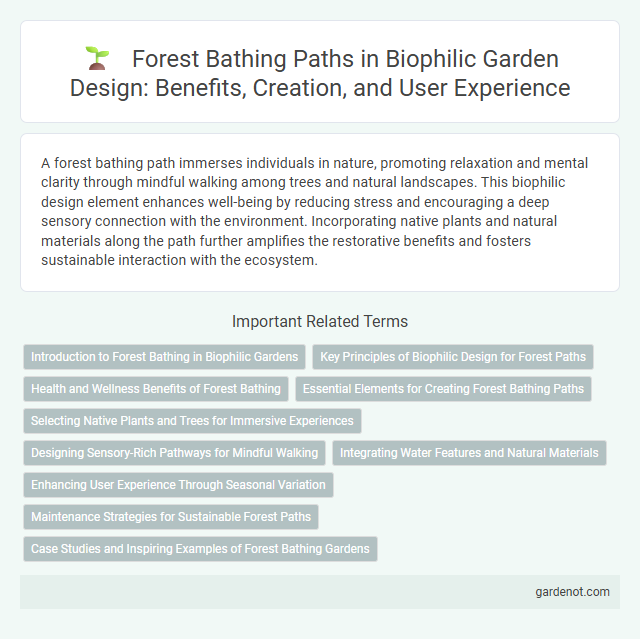A forest bathing path immerses individuals in nature, promoting relaxation and mental clarity through mindful walking among trees and natural landscapes. This biophilic design element enhances well-being by reducing stress and encouraging a deep sensory connection with the environment. Incorporating native plants and natural materials along the path further amplifies the restorative benefits and fosters sustainable interaction with the ecosystem.
Introduction to Forest Bathing in Biophilic Gardens
Forest bathing paths in biophilic gardens immerse visitors in natural environments designed to stimulate sensory engagement and promote mental well-being. These pathways incorporate native flora, natural textures, and ambient sounds to enhance the therapeutic effects of forest immersion. Scientific studies show that exposure to such environments reduces stress hormones, improves mood, and supports cardiovascular health.
Key Principles of Biophilic Design for Forest Paths
Forest bathing paths integrate the key principles of biophilic design by emphasizing direct engagement with natural elements, fostering multisensory experiences through textures, sounds, and scents of the forest environment. These paths maintain natural patterns and asymmetry while encouraging spatial variability to promote exploration and relaxation, enhancing psychological well-being. Incorporating natural materials and visual connections to greenery supports a restorative atmosphere aligned with biophilic design's intrinsic connection to nature.
Health and Wellness Benefits of Forest Bathing
Forest bathing paths enhance mental clarity and reduce stress by immersing participants in natural woodland environments, which stimulate the parasympathetic nervous system and lower cortisol levels. Exposure to phytoncides, antimicrobial compounds released by trees, boosts immune function and increases natural killer cell activity, promoting overall physical health. Regular walks along forest bathing trails improve cardiovascular health, decrease blood pressure, and elevate mood through increased serotonin production and mindfulness practices.
Essential Elements for Creating Forest Bathing Paths
Essential elements for creating forest bathing paths include diverse native vegetation to stimulate the senses and promote relaxation, well-maintained natural trails that encourage slow, mindful walking, and strategically placed seating areas that invite contemplation and connection with nature. Incorporating water features such as streams or ponds enhances auditory and visual tranquility, while ensuring safe access with minimal environmental disruption preserves the ecosystem's integrity. Thoughtful integration of natural textures, scents, and sounds supports immersive, therapeutic experiences that foster mental and physical well-being.
Selecting Native Plants and Trees for Immersive Experiences
Selecting native plants and trees enhances the authenticity and ecological balance of a forest bathing path, creating an immersive environment that stimulates all senses naturally. Indigenous species support local wildlife, improve air quality, and foster deep connections between visitors and the natural landscape. Carefully curated native flora ensures resilience to regional climate conditions while promoting mental restoration and physical well-being through biophilic design principles.
Designing Sensory-Rich Pathways for Mindful Walking
Designing sensory-rich forest bathing paths enhances mindfulness by engaging sight, sound, touch, and smell through diverse vegetation, textured surfaces, and natural aromas. Incorporating varied plant species, water features, and subtle elevation changes creates a dynamic environment that promotes relaxation and stress reduction. These immersive sensory elements foster deeper connections with nature, supporting mental well-being and restorative experiences.
Integrating Water Features and Natural Materials
Forest bathing paths that integrate water features such as streams, ponds, and waterfalls enhance sensory immersion, promoting relaxation and stress reduction. Utilizing natural materials like wood, stone, and moss in the pathway construction fosters a harmonious connection with the surrounding environment and supports biodiversity. These elements work synergistically to create a therapeutic outdoor experience grounded in biophilic design principles.
Enhancing User Experience Through Seasonal Variation
Forest bathing paths enhance user experience by integrating seasonal variations that highlight changing foliage, scents, and natural sounds, fostering deeper sensory engagement. These paths incorporate diverse native plant species that bloom at different times, creating dynamic landscapes that encourage repeated visits throughout the year. Seasonal elements such as autumn leaves, spring blossoms, and winter evergreens amplify mindfulness and relaxation, aligning with biophilic design principles.
Maintenance Strategies for Sustainable Forest Paths
Maintenance strategies for sustainable forest bathing paths emphasize erosion control, native vegetation preservation, and periodic trail assessments to minimize environmental impact. Utilizing permeable materials and implementing water drainage systems help prevent soil compaction and habitat disruption. Regular community involvement and adaptive management practices ensure the long-term health and accessibility of forest paths.
Case Studies and Inspiring Examples of Forest Bathing Gardens
Forest bathing paths exemplify biophilic design by integrating natural landscapes to enhance mental well-being and reduce stress. Notable case studies include the Shinrin-yoku trails in Japan, which utilize curated forest environments to promote mindfulness and health benefits through immersive nature experiences. Inspiring examples such as the Chichibu Forest Therapy Area showcase how specific plant species, natural soundscapes, and carefully designed walking routes optimize emotional restoration and sensory connection in urban green spaces.
Forest bathing path Infographic

 gardenot.com
gardenot.com